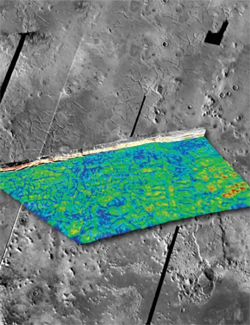Polygon puzzle
 Martian polygons formed under similar conditions to those on Earth, say scientists, and lend support to ‘wet Mars’ hypotheses. Kea Giles reports.
Martian polygons formed under similar conditions to those on Earth, say scientists, and lend support to ‘wet Mars’ hypotheses. Kea Giles reports.
Geoscientist 22.09 October 2012
Caption: Terrestrial deep-water marine polygons (front, colour image) are potential morphological and genetic analogs to large-scale Martian polygonal features (grayscale). Front: The terrestrial deep-water polygons are imaged using 3-D seismic-reflection data acquired by the oil and gas industry in offshore Norway (Brygge Fm.). Background: THEMIS imagery shows the character of large-scale Martian polygons in Acidalia Planitia (Vastitas Borealis Formation). © The Geological Society of America, Inc.
Debate continues over the origin of large-scale Mars polygons hundreds of metres to kilometres in diameter, after decades of detailed observations. Similarity in geometric patterns on Mars and Earth has long captured the imagination. Geologists at the University of Texas at Austin examine these large-scale polygons and compare them to similar features on Earth's seafloor, which they believe may have formed via similar processes. Understanding these may in turn support the idea of ancient oceans on Mars.
Through examination of THEMIS, MOLA, Viking, and Mariner data and images, planetary scientists have found that areas on the northern plains of Mars are divided into large polygon-shaped portions. Sets of such polygons span extensive areas of the Martian surface.
Writing in GSA Today, Lorena Moscardelli and her colleagues from The University of Texas at Austin present a detailed comparison of the geometric features of these large Martian polygons and similar features found in deep-sea sediments here on Earth.
Fine-grained
On Earth, polygon-shaped areas, their edges formed by faults, are common in fine-grained deep-sea sediments. Some of the best examples occur in the North Sea and the Norwegian Sea and have been imaged by 3D seismic surveys conducted in the search for offshore oil and gas deposits. These deep-water polygons tend also to be a kilometre or more across.
Moscardelli and her colleagues conclude that the majority of these polygons form in a common environment, when fine-grained clay sediment in ocean basins deeper than 500m are shallowly buried by younger sediments. Typically the physical mechanism of polygon formation requires the existence of a thick, wet, and mechanically weak sediment layer.
Moscardelli and colleagues believe that the angle of the sea-floor slope plays an important role in both the formation and preservation of polygons. Where the seafloor slope is gentle (less than half a degree), polygons have very regular shapes and sizes. In many locations where polygons have formed on top of buried topographic features, the shapes of the polygons were altered, and in some cases broken up and disrupted where the slopes were steepest. Both observations are consistent with deformation of soft marine sediments as they creep or flow down slope.
Northern Plains
On Mars’s northern plains where the surface is basically flat, polygons have very regular shapes and sizes - remarkably similar to those found on Earth. In places where the topography on Mars is more varied, and where there may be evidence for other sediment-transport features on the surface, areas of deformed and disrupted polygons can be found – again, similar to disrupted polygons here on Earth.
On the basis of these striking similarities, the team argues that the Martian polygons were formed within a thick, wet, and weak layer of fine-grained sediments that were deposited in a deep-water setting, similar to the Earth polygons. Thus, these interesting geometric features may provide additional evidence for the existence of an ocean in the northern portion of Mars approximately three billion years ago.
Reference
- Deep-water polygonal fault systems as terrestrial analogs for large-scale Martian polygonal terrains Lorena Moscardelli, Tim Dooley, Dallas Dunlap, Martin Jackson, and Lesli Wood, Bureau of Economic Geology, Jackson School of Geosciences, The University of Texas at Austin, Austin, Texas 78713-8924, USA. Pages 1-9; doi: 10.1130/GSATG147A.1, www.geosociety.org/gsatoday/archive/22/8/.